|
|
|
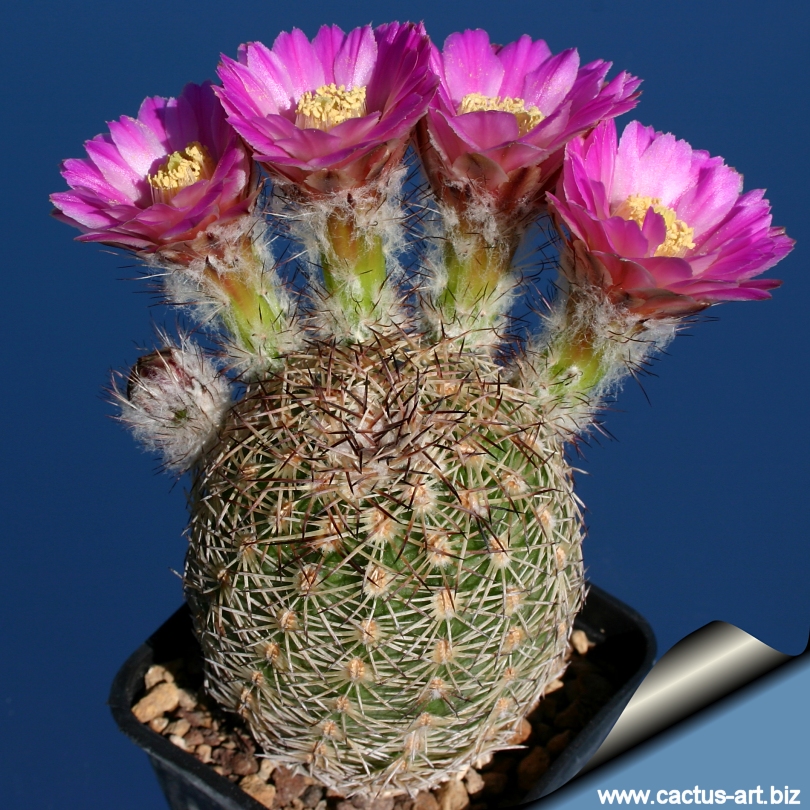
E. adustus
SB72 Cosihuiriachi,
Chih. Mexico
Very nice, frilly, purple-pink flowers, somes plant
with black centrals. |
Description: Usually solitary.
Stem: Green, short, cylindrical,
up to 20 cm tall 4(12) cm in diameter.
Ribs: 11 to16, 5-12 mm long
Root: Fibrous.
Areoles: Ellipsoidal, length 3–4mm, width 2 mm, close set,
distance 4-7 mm, at first woolly, then naked.
Radial spines: 5-18, pectinated 16-23 mm long. Cream with darker
tips add-pressed.
Central spines: 0 - 1, up to 35 mm long, brown-black, stiff and
straight.
Flowers: Magenta-pink, throat a lighter shade, 45-60 mm long, 40-55 mm
wide. Tube length 20-40 mm, filament 15-25 mm long, stylus 25-40 mm,
yellow, stigma lobes 5-6 yellowish-green.
Fruit: Ovoidal, brownish-green, length15, diameter 10.
They dry
and break at maturity and ripe in 2 months.
Seed: 1-1,5 mm black.
Central spines: Adult
plants, either without central spines, or with
1 central spine can be found. But with the exception of the
absence or existence of centrals, all the other characteristics are
absolutely identical, namely size and form of ribs, number, size
and arrangement of radial spines, flowers, fruits and seeds.
Furthermore
this species is one of those Echinocereus which pass a purely
radial-spined long youth stage, in which they are already floriferous.
Most of the plants after several years develop central
spines, giving the plant its sea urchin appearance.
|
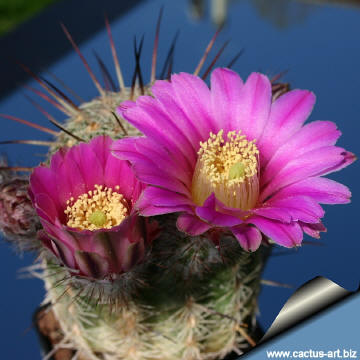 |
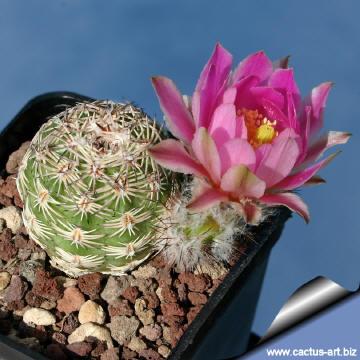 |
|
. |
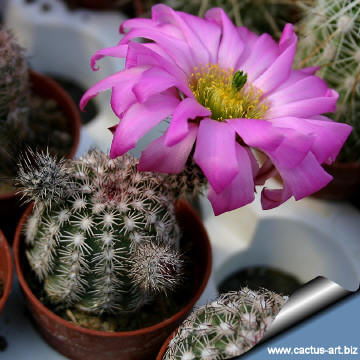
|
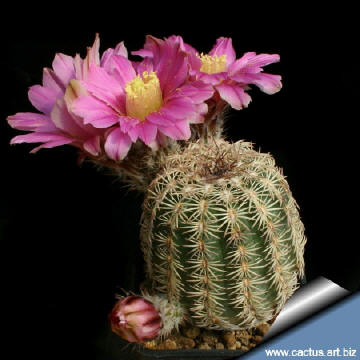
|
|

|
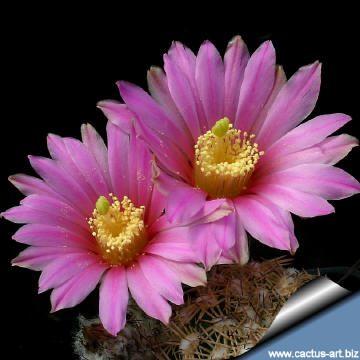
|
|
Photo of conspecific taxa,
varieties, forms and cultivars of Echinpsis pectinatus:
(This taxon has lots of synonyms (like
most Echinocereusi ), with several controversial varieties and subspecies):
Advertising
|
|
|
|
|
Family:
Cactaceae (Cactus
Family)
Scientific name:
Echinocereus adustus Engelm.
in Wisliz., Mem. Tour. No. Mex. 104. 1848.
TL: Chihuahua: Cusihuiriachic, 1900m
NN, WISLIZENUS 1846
Holotype: Co- sihuiriachi, Mexico,
1846, A. Wislizenus s.n. (2 sheets).
Neotype: México: Chihuahua:
Cusihuiriachic, J.N. ROSE 11664, 02 April - 03 April 1908 [US 454379]
Origin:
Mexico, Chihuahua: Cusihuiriachic, Sahuirachic and north of city of
Chihuahua
Habitat: Desert grassland, on loamy soils, on stony
hills, altitude 1800-2400m
Conservation status: Listed in
CITES appendix 2.
|
|
|
|
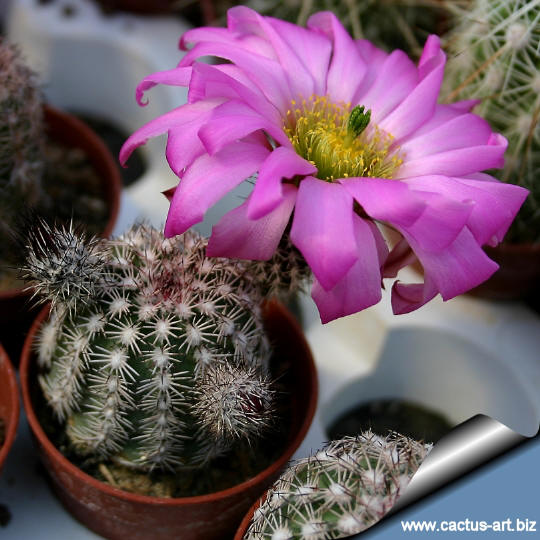
A young specimen
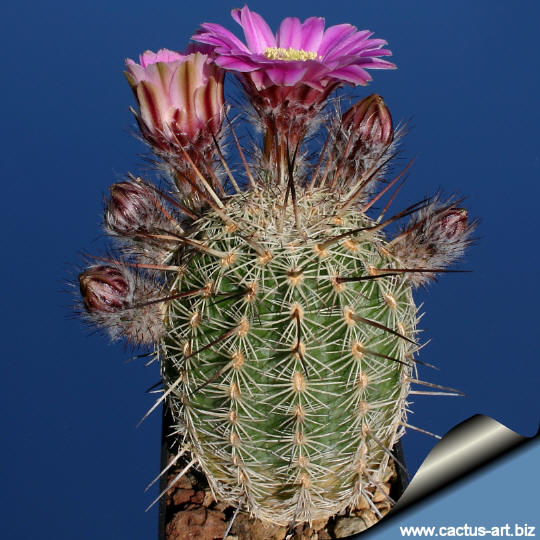
A mature specimen
Synonyms:
- Cereus adustus (ENGELMANN) ENGELMANN.
In: A. GRAY. - Pl.Fendl.: 50 (1849)
- Echinocereus radians ENGELMANN.
In: WISLIZENUS. - Mem.Tour North.Mex.: 104 (1848)
- Echinocereus. rufispinus
ENGELMANN.
In: WISLIZENUS. - Mem.Tour North.Mex.: 104 (1848)
- Cereus rufispinus (ENGELMANN) ENGELMANN.
In: A. GRAY. - Pl.Fendl.: 50 (1849)
- Echinocereus pectinatus var. adustus SEITZ.
In: Cat.cactearum cultarum: 11 (1870)
- Echinocereus pectinatus var. rufispinus SEITZ.
In Cat.cactearum cultarum: 11 (1870)
- Echinocereus pectinatus var. adustus DAUL.
In: Handbuch Kakteenkunde: 78 (1890)
- Echinocereus pectinatus f. adustus VOSS.
In: Villmorin's Blumengärtnerei ed. 3: 378 (1894)
- Echinocereus pectinatus f.
rufispinus VOSS. In:Villmorin's
Blumengärtnerei ed. 3: 378 (1894)
- Cereus adustus var. radians (ENGELMANN) J. COULTER.
In: Contr.U.S.Nat.Herb. 3: 387 (1896)
- Echinocereus pectinatus var. adustus (ENGELMANN)
SCHUMANN.
In: Gesamtb.Kakteen: 271 (1898)
- Echinocereus pectinatus var. rufispinus (ENGELMANN)
SCHUMANN.
In: Gesamtb.Kakteen: 271 (1898)
- Echinocereus caespitosus var. adustus
(ENGELMANN) BORG.
In: Cacti ed. 1: 174, (1937) nom.inval.
- Echinocereus caespitosus var. rufispinus SCHUMANN
ex. BORG.
In: Cacti ed. 1: 174 (1937) nom.inval.
- Echinocereus caespitosus var. adustus (ENGELMANN)
BORG.
In: Cacti ed. 3: 221 (1959) nom.inval.
|
|
Cultivation: In culture E. adustus is without
problems, easy to grow, very attractive and regularly shows its
beautiful flowers, if provided
with an adequate winter rest period. It is
sensitive to over-watering (rot prone),
and needs good drainage. Keep
drier and cool in winter. Needs
full sun. In
the summer they need an airy location in bright sun; well watered when
it's hot. To achieve the best spine density
give these plants lots of sun. In the winter
light, cool, and absolutely dry conditions.
Very cold resistant above -12° C or less for short periods of
time.
In mild climate they grow well when planted freely outside
in well-drained soil.
Propagation: Seeds
(usually), it also can be grown from cuttings, as it can branch from the
base.
|
|

 |
|